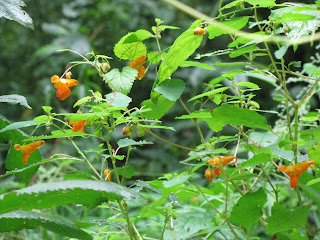Just like everything else in my garden, the squash are coming ready for the harvest much earlier than usual. I've actually never had squash harvested as early as this year so this will be an experimental year. Because I store my squash in the root cellar whole, and they usually last until April or so of the next spring. I'll have to see how long these squash will last. In March the new spring garden is just being planted and even the early greens aren't ready for eating. If the food in the root cellar goes bad too early it's a struggle to make it until the new garden starts producing food to eat. We'll see...
Squash is one of the Three Sisters or one of the three sacred plants that kept certain American Indian tribes alive through the winter. The other two plants are maize (American corn) and climbing or pole beans. There are many legends to say how they came to be called The Three Sisters and it is interesting to see how all the agricultural tribes are similar yet different.
Squash is a very important part of my diet. Because I live in Wisconsin, I don't have the long growing season that many people do. To get calorie dense food out of our short growing season can be difficult. Squash is one of those foods that fits the bill. My favorite way to eat it is baked with maple syrup drizzled over it. but I have many different recipes that I use, just because my root cellars are usually filled with squash.
When harvesting squash, just like harvesting every other food, some of it is only partially good and has to be processed right away. Dehydration is my favorite way of storing this in a squash leather of sorts. I cut out the bad spots, take out the seeds and bake the squash until soft. Then scrape it out of the shell and puree it in a food mill, food processor or blender. To this I add maybe some honey or maple syrup, and some spices, usually cinnamon, nutmeg or even pumpkin pie spice. I will also mix the squash puree with pureed apples or even tomatoes (this sounds bad but it is actually really good). Then I put it into the dehydrator and dry it.
You can easily make a solar dehydrator by laying some plastic wrap over a screen propped up by bricks so that air can flow underneath it. This can be on any type of raised surface such as a picnic table. The put a second layer of bricks around the outside edge and carefully drape cheese cloth over this so it doesn't touch whatever you have on the plastic wrap. Make sure this is in full sun and it works really well if it is on the south side of a building (here in the northern hemisphere).
If you don't want to go through all of that, smear the puree on a flexible surface (aluminum foil is okay) and put in your oven. Set at the lowest setting you can or 140 degrees F and crack the oven door. Take care if you have animals or small children around so the don't burn themselves. Let this sit for several hours and check. When you can peel the now leather off its surface, flip it over and let it dry of a couple more hours. Put in a moisture-proof container and store in a cool, dry, dark place. Or eat it right now. It doesn't last long around this house. lol
Another thing I do with squash that I have to use up right away is squash soup. This is one of my favorite fall and winter meals. I often make a big pot of it and eat on in for a week (or until guests come over and eat it all). This soup with a good crusty bread makes an excellent meal for those cold, snowy days when all you want to do is stay hunkered down in the house.
What you need are:
- 1 medium yellow onion, chopped
- 1 rib of celery, chopped
- 1 carrot, chopped
- 2 Tbsp butter
- 1 butternut squash, peeled, seeds removed, chopped
- 1 tart green apple, peeled, cored, chopped (squash and apple should be at a 3 to 1 ratio)
- 3 cups chicken broth (or vegetable broth if vegetarian)*
- 1 cup water
- spice of your choosing-if you like it sweeter some maple syrup or honey with cinnamon, nutmeg and/or pumpkin pie spice or for a more savory flavor, parsley, rosemary, chives and/or thyme
Method
1 Set a large saucepan over medium-high heat and heat the butter for 1-2 minutes. Do not let it turn brown. Add the onion, celery and carrot and saute for 5 minutes, taking care to turn the heat down if the vegetables begin to brown.2 Add squash, apple, broth and water. Bring to boil. Cover, turn the heat down to a simmer and cook for 30 minutes or until squash and carrots soften. Puree, and return to a clean pot.
3 Add salt and spices to taste.
I like to put in a huge dollop of sour scream or even mix some in after the puree (and still put another dollop on it). It can be served hot on cold winter days or cold on warm late summer days. This can be doubled or tripled, or made in a huge cauldron to feed an army. It is even better tasting the next day.
For me this is the introduction or gateway into autumn. The calendar may not say it is fall yet, but the garden is yelling it loud and clear. I have a tendency to listen to the garden.
P.S., The bread is a pumpkin bread with chopped up bits of autumn olive and apple leather mixed it. Perfect to go with squash soup.

















































